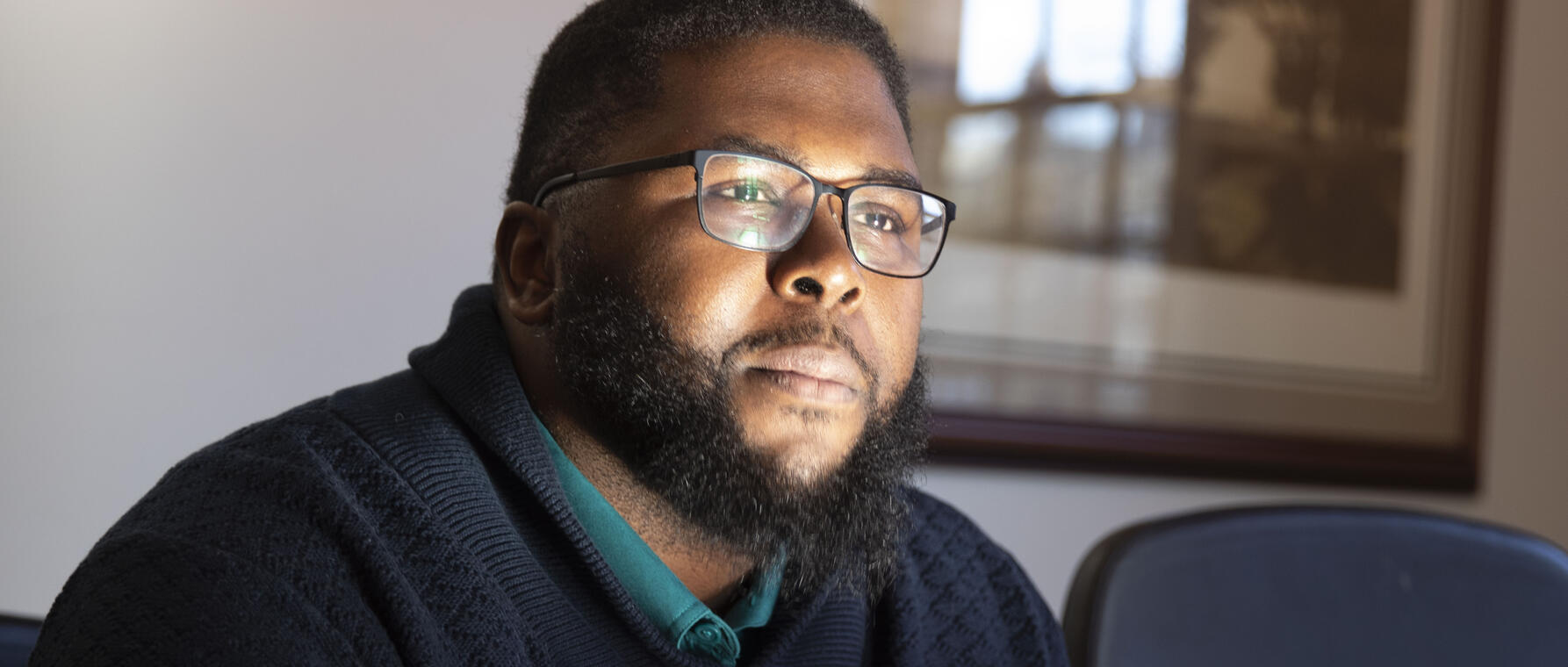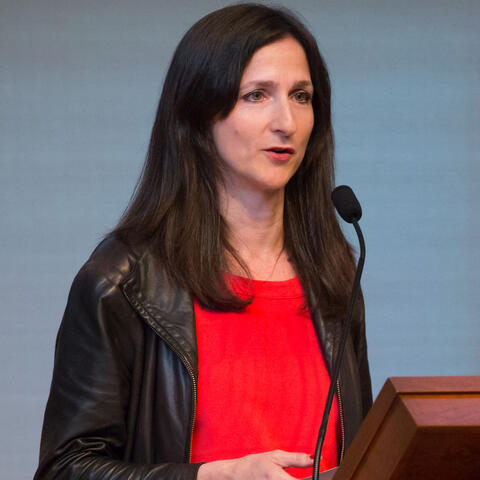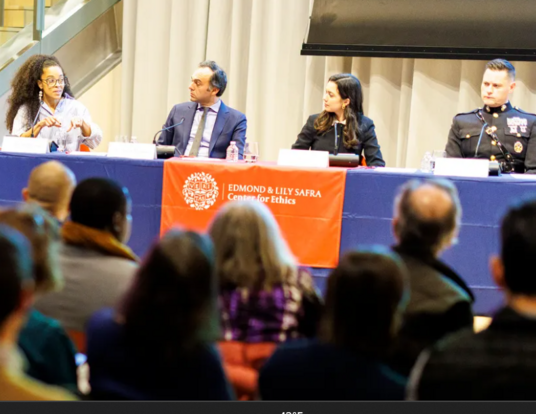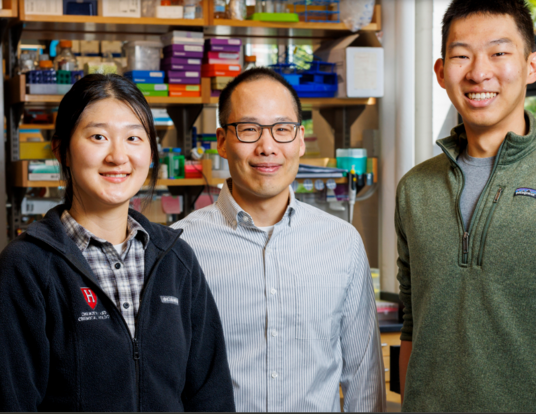Colloquy Podcast: How the Problems of Home Pierce the College Bubble

Research at Risk: Since World War II, universities have worked with the federal government to create an innovation ecosystem that has yielded life-changing progress. Now much of that work may be halted as funding is withdrawn. Find out more about the threats to medical, engineering, and scientific research, as well as how Harvard is fighting to preserve this work—and the University's core values.
The Boston University sociologist Anthony Abraham Jack, PhD ’16, says American higher education wasn’t ready for the diversity it was recruiting before the Supreme Court of the United States ruled it unconstitutional to consider race in college admissions—and it's still not ready now. In his books The Privileged Poor and Class Dismissed, Jack shows how schools often fail to acknowledge the inequities of class and race that follow students from home to campus. The solution? Pop the campus bubble and begin looking at the ways that place impacts the challenges low-income and first-generation students face.
The following conversation took place in March 2025 at an event hosted by the School’s Office of Alumni Relations. It was moderated by Jennifer Flynn, senior director of global outreach. It has been lightly edited for clarity and correctness.
Tony, you said your own background has made you keenly aware of the class inequalities that come to college when universities diversify along socioeconomic lines. Would you be willing to share a little bit about your own journey and how that informed your research?
So, I always start with two things. I'm a Head Start kid and I'm a first-generation college student, because both of those things serve as the foundation for much of my research. There was no roadmap for me for going to school. There were aspirations. There were dreams. There were a lot of wishes and hopes. But as far as concrete steps on how to get to college or what to do while there, it was generally absent.
And so, for me, it was being that sojourner, being that first person to experience so much for my family. And so, I was able to use that as a foundation and ask myself a lot of questions, actually. I remember in the opening of The Privileged Poor, I asked myself, where are all the other poor Black students? Because I really thought—I was like, everybody kept talking about private jets and studying abroad in high school, and going to all of these very, very ritzy places. And I'm saying to myself, “That’s well beyond my pay grade, well beyond my understanding.”
And then I realized—actually, when I was sitting in [Harvard’s] William James Hall—that the experiences that I had at Amherst [College], my divergent experiences that I had there, were not an anomaly, per se, but actually something that can be studied, something that can be examined. And that's actually what I did. I talk a lot in my research about office hours and how certain students come into college knowing exactly what office hours are. Others, quite frankly, do not. And it depends on their trajectory to college.
Professors always say when office hours are; they never say what they are. And fortunately, I had one year at a private school in between my 11th-grade year—my final year was at a private school. I got a taste of how the top 1 percent was educated. I got a sense of the different kinds of experiences. That actually served as the foundation, eventually, as I was sitting in William James Hall, for The Privileged Poor. I talked about how students’ trajectories to college fundamentally shaped their experiences in, especially with, the unwritten rules of higher education—that hidden curriculum. But then I also was that same student who went hungry during spring break. Before The Privileged Poor, only 18 percent of colleges that had adopted a no-loan financial aid policy actually opened their dining halls during spring break. So that means the vast majority of them [did not], right? More than four out of every five schools shut down.
But what do lower-income students who could not afford to go home do? So those experiences serve as the foundation for The Privileged Poor. I was able to take these personal experiences of being othered by university policies and practices and actually translate that into an examination of how structural inequalities—those who come from low-income backgrounds, who don't have the same economic or cultural capital—experience these institutions in such drastically different ways. And that's when that melding of personal experience and social inquiry came together.
How do you think Class Dismissed has built on the work of The Privileged Poor? How have you used your previous research as a lens for this new book?
Class Dismissed came about because I felt like something was missing from The Privileged Poor, in the sense that I wanted us to fundamentally realize that when students come to college, home does not leave them. The things outside the college gates fundamentally shape how students manage their daily life.
The Privileged Poor—it gives us a very intimate, in-depth look at the everyday experience of students. But it inadvertently reifies the idea of a college bubble, in the sense that even though it pushes back against it, it's still saying, if we look at what's happening on campus and on campus only, we can have an understanding of what policies to change. Class Dismissed picks up where The Privileged Poor left off, and it says, let’s get rid of the college bubble as a metaphor. That’s a goal of mine with this book.
I want us to understand how the problems of home pierce the college gates in very classed and racialized ways. And I wanted us to fully understand the ways in which neighborhood inequalities affect students in very specific ways, and how that allows us to be more attuned to urban poverty and rural poverty. Because whereas our students who come from inner cities—they use apps like Citizen—whereas most people use the Citizen app to figure out, oh, there’s a water main break on 3rd Street, there’s a lamp out on Lincoln Ave., avoid those areas, a lot of our urban students use Citizen to see how close danger is. Whereas people like to avoid those parts of the city, they use it as a sonar, trying to figure out how close those problems are. And how they no longer wait for an Instagram post or a text from their parents. They’re always on alert.
Well, how do we plan for that? How do we understand that? And then our rural students—the way in which those responsibilities and those calls from home look and feel very different because their responsibilities are slightly different. How do we use that knowledge of home coming to college to better influence how we think about mental health services—not only who we hire, but also how we train them?
Because right now, mental health officers know how to help students through divorce of parents and death of grandparents because those are most disruptive life events for seventeen- to twenty-three-year-olds. But when you think about place and how that plays into what problems students face, it looks very different when you start looking at ZIP codes. It looks very different when you start looking at the hollows of West Virginia. And so those are the things that we absolutely need to understand to be able to prepare for those students who we now so ardently recruit.
I'd like to pull on this string a little bit more because all of these problems that students are taking to college have existed for a long time. But I'm wondering if you could speak a little bit more about how the COVID pandemic, which is an element of your book, Class Dismissed—how did that exacerbate these inequalities that already existed?
I think working is a good example of how COVID illuminated so much. So almost five years ago to the day, when campuses shut down, we thought that all work stopped. All students went home, and work stopped, and they all just became students. And that’s not true, right?
When COVID closed campuses across the country, lower-income students, we discovered—and I discovered in the book—were more likely to be in manual labor and food service jobs, like dorm crew, barista, dining services. Middle-class and more affluent students were actually more likely to be working as research, course, or teaching assistants. Now, lower-income students worked because they had to—not only because of federal work-study, but also because they were already sending money home.
Middle-class students reported working for—as one student said—because she wanted to try all the Indian restaurants in Boston. Another student actually called, and she said that she wanted to work so that she could afford things “like for [expletive] and giggles,” was the phrase she used. And we had a good laugh about her framing. The thing is, when COVID closed, middle-class students continued to work, and lower-income students stopped working.
And so, what I use in the book is to show that there has been a segregated labor market on our college campuses that had existed for a very long time. COVID just provided the conditions to actually see it and then study it. Because what you actually see is that because lower-income students were more likely to be resistant to go to office hours because they were unfamiliar with the unwritten rules of higher education, whereas their middle-class peers were more proactive in going to office hours and befriending faculty—access to those high-impact positions that provide both pay for hours worked, but also additional forms of capital like letters of recommendation, introductions, knowledge—it was a class-divided system. And because universities take such a hands-off approach on helping students find work, this class-segregated system continues, having both immediate impacts on campus now.
But also, you can imagine the long-term implications of who gets jobs, who gets internships, who gets those letters of recommendation that permit you to get access to the kind of things that we all want for our students. The University of Nebraska, actually, in 2022—I believe—actually changed their policy about how work happens now. And what they’re doing is all jobs now have to be posted on a central website—one website, every single job. Whereas at Harvard and other places, jobs are everywhere.
You sometimes get jobs in office hours where it was never posted. It was handed out like candy on Halloween. You have to be at the door to get it. There are some jobs that are on the OCS website. There are some jobs on career services. There are some jobs on departmental websites. It's a motley crew of things.
But what happens when you have a systematic system where everybody gets equal access to information? At least one part of the application process is democratized. So COVID revealed that and allowed me to study it and then allowed me to develop policy recommendations so that universities can adapt to it to at least ameliorate that class inequality.
How did the fact that Harvard College and many other colleges at the time of your research had worked to really diversify their student body—and Harvard at that time was majority minority—what particular challenges did those students from diverse backgrounds face when campus closed during COVID? And what are the costs to students of being a member of an unprecedentedly diverse class?
It seems like forever ago to think that Harvard and other colleges—other selective colleges—actually admitted their first majority nonwhite class. It was like 50.3 percent or 50.7 percent nonwhite, which, if you think about today, it’s almost like we have entered a new era with the [2023 US Supreme Court] Students for Fair Admissions case—the new post–affirmative action world in which we live.
But what [Pennsylvania State University researchers] Megan Holland and Karly Ford talk about with that cosmetic diversity is the almost reflexive, unthinking need to just post as many Black and Brown faces on viewbooks and websites as you possibly can. There was literally a study that showed that there is almost 20 to 40 percent, I believe, more diversity in college viewbooks than you will actually see on the college campus. Access is not inclusion.
And yes, you may be admitting a class that’s 50.7 percent nonwhite. You may be admitting a class in which one out of eight students is the first in their family to go to college. But what are their experiences on campus? Harvard just recently announced that it would raise its no-loan financial aid eligibility from $80,000 to effectively $200,000. If your family makes less than $200,000, you will come with at least no tuition. And if you make less than $100,000, you will come to school with no tuition and other room and board issues paid for.
That’s huge. Stanford and Columbia had it at $150,000. There’s been what I call this “no-loans arms race.” It’s aimed at diversifying campuses, but also at realizing that we are pricing out working-class and middle-class families in higher education—or we have been doing so for a very long time. Because the fact that some colleges are now crossing that barrier of $100,000 all-in cost of attendance per year is scary to any family that makes anywhere near the median amount of money in this country.
And so those are the things that [Holland and Ford] are talking about: that cosmetic diversity. And I always say, well, now the mascara is starting to run, especially when you think about the experience of students. Yes, students are still going hungry during spring break. And we are starting to make that change.
I worked with Rakesh Khurana, who’s now the outgoing dean of Harvard College, on changing Harvard’s policy for the first time back, I believe, in 2014. And so, in 2013–2014, we first had these conversations. But COVID also revealed something very clear, because we were all home when things went down in Minnesota with George Floyd. Most of us were home—I say “Home” in the big-H way, because some of us were in rented places, on islands, and all that kind of stuff like that. But the world was watching Minnesota.
The world was watching the callous disregard for Black life that was posted on social media and online for all to see in a way that we had not seen for a generation or two. And so, when we think about the ways in which the social unrest that happened along racial lines—it exposed how ill-prepared universities were for the diversity that they so ardently just posted everywhere you can possibly find it. And a lot of students were left just feeling absolutely lost: How are you going to celebrate us on one day but then can’t help us in any kind of way the next?
And one thing that scared me was the number of students—the number of Black students specifically, but the number of Black, [Indigenous], and Latino students—who said that they would not run for office. They didn’t want executive board positions in their clubs. And when they told me why, they were like, well, because the university was asking us to do their job. We were the ones that were having sessions for students who needed to have community. We were the ones who were doing the writing of emails and things like that. We were the ones who were doing what we thought the university should do, and we’re tired.
And we see that echoing all across academia—the number of college presidents who have stepped down, deans who have stepped down, who are more reluctant to have leadership positions. That was happening at the student level. The thing is, if students were not—and everybody knows that the credential game is heavy at Harvard—if students aren’t in leadership positions, your résumé is going to look very different than when you go on the job market.
If you look at the work of Lauren Rivera, who I believe graduated from [Harvard Griffin GSAS], who’s now at Kellogg School of Management, she shows how your résumé means a lot when you go for applications at consulting firms and all those things. They want leadership positions. And so, students were just tired.
There are two questions that I want to ask that are related to what we’ve just been talking about. So first, how do colleges think critically before students get to campus about the students that they’re bringing here? And then what do they need to do to actually support them once they arrive? And then along those lines, how do institutions need to think about distributing this collective labor that we’ve been asking students of color and Indigenous students to do?
I think a lot of the lessons that the dean of students offices across the country need to grapple with—it begins—I think some of the answers are already there on their campuses in the admissions office. Admissions officers know the communities and the high schools that students come from. And previously all the information that was shared from admissions to the dean of students was just who gets to be in advanced math and who gets to be in intro math, or who gets to skip intro chemistry to go straight to organic chemistry because their high school was so powerful or whatever. That’s where the conversation really stalled. It’s academic placement.
But in those files is so much of the texture of life of our students en route to campus. So much of their reality is housed in those letters that they wrote, the letters from the counselor at the schools. And we understand the communities that they come from. Why do we not share that information more concretely with the people who are then responsible for making sure that students make it from convocation to commencement? If it can help us get an understanding of how to create a class, it can help us in supporting that class.
So, are there questions they should be asking themselves? Is there training that needs to happen for admissions officers and student affairs folks to come together to really think about and understand place-based inequalities and the kinds of hurdles students face coming to college so that they can really support the students as they deal not only with the new responsibilities of college, but also with the pressures of home that they’re bringing with them?
That does require greater training in our student affairs and dean of students offices. But not just them—career services need to have an understanding of the social pressures that students from lower-income, first-generation, and rural backgrounds have about their experiences at Harvard, at Amherst, at Boston University, at Washington University, at the University of California, Los Angeles, at these institutions, because there are different pressures. There are different realities that we need to fundamentally understand to be able to be best supportive of our students.
And so, there were places that were doing this work. And some of them were housed under offices that were essentially called some combination of diversity, equity, inclusion, and belonging. And a lot of those places have been phased out—sometimes prematurely. Our universities do not have a good relationship, and an even worse history, of supporting [Indigenous] students. But we could actually partner with different associations and different tribes to understand, “Hey, what do we need to know about students today? How can we support our students? How can we partner and support our students who are coming to our college from your tribe?”
[Indigenous] students are often asked to take leave more often than any other group of students across the board. And there was a university that said, “Well, when they come back, we will invite an elder to come to campus with them to help reintegrate them into campus.” And I asked the question—I said, “Why are you waiting until a student fails—or stumbles, at least—to have a policy like that?” You are almost expecting and waiting rather than proactive.
Because what would happen if—because you only get so few [Indigenous] students a year, six to four, maybe even less than that—what would happen if you have a program where that first-year orientation, before that program starts, you invite those people to campus? And you have that conversation. You do an initiation, not a reinitiation.
Why do universities fight having pre-orientation programs for first-gen students, but they freely and willfully have them for international students? The same rules—the reasons why you want one for international students—90 percent of the reasons why are going to apply to first-generation college students. It’s about understanding the priorities and understanding, “How do we meet students where they are, not where we want or where we wish them to be?” And that requires a different kind of approach and a reorienting of ourselves, really, about what we expect from them.
One thing about leave policy—if anyone has ever had someone in their family or themselves been asked to go on leave, they may know this more intimately. And this is what I mean by understanding where students come from. So, I looked at the top 25 private, public, and liberal arts colleges in the country, and I scoured their student life handbooks, and I looked at their academic leave policies. And I discovered something that was quite—it stuck with me, and it hurt to actually read it.
The way in which universities penalize students who are asked to be on leave—and I fundamentally believe that the vast majority of people who are put on academic leave are put on there because they could not manage the new role of student with the old responsibilities of home. I think that a lot of students cut corners because they overcommit themselves to doing things on campus while also trying to maintain that tie to home. They work extra hours, and they study less. That is a big phenomenon going on among lower-income students.
When a student is placed on leave at Harvard, for example, the things that they must do to return are onerous and sometimes conflict—they make it almost impossible for them to compete, based on where they come from. And what I mean by that is, if you are put on leave, you have to hold down a full-time job while you are away. You also have to get two letters of recommendation to come back—one from your employer and one from somebody who’s going to attest to your mental state.
But what happens when you come from a neighborhood that has only a 60 percent employment rate because there are no jobs? What if you come from a rural background where the local mine has recently closed? Or you come from a reservation where joblessness has been a consequence of land theft and settler colonialism? What do you do? You lose the right to be on campus. And also, I would say, all access to things like career services that could help you find employment when you are away from campus.
But you have to find these jobs. And is working at Target or Eckerd’s or Duane Reade—is that eligible? If you can even find that? During COVID, some students had to go out and work because their ability to return was predicated on working 40 hours a week.
But that letter of recommendation is equally challenging, because think about the power dynamic that that then puts into students’ lives. Going to a person and saying, “Hey, I need you to sign off on this.” First of all, they have to reveal that they’ve been kicked out of school, divulging very personal information. And now that supervisor has power over them to say, “Well, I won’t sign this,” or something like that. And I’m not saying that every manager will do that, but we’ve had plenty of examples of it happening.
And then what happens if you come from a community where you are not just the first in your family to go to college, but you’re one of the few in the entire surrounding area to do so? A letter of recommendation is not something that is a staple thing in people’s lives. And so, we may be used to letters of recommendation because of the jobs that we apply for, but other people apply for jobs where it’s just the application.
I know we just have a few minutes left, and I did want to end our conversation with two related questions. So, what do you hope university leaders will take away from [Class Dismissed]? Not about how to prepare if there’s a future pandemic, but rather, how do they look at current policies and practices that are creating a potentially separate but unequal experience for students who come from neighborhoods that are still healing—not just from COVID, but from generations of exclusion? And then, are there any great examples out there? Have any schools developed new traditions and new policies that truly make their campuses more equitable and accessible? Is there any guiding light that we should be looking to for the future as we think about these issues?
If you look at Georgetown [University’s] handbook, Georgetown effectively said, the reasons for breaks come in all shapes and sizes. Some of you will be doing an internship, some of you will be going to the White House, some of you will be traveling, and some of you will need time away from the academic grind to come back stronger and better than before. They literally equated any kind—and it’s not a false equivalence, like all leaves are equal—but it was like, the reason for your leave is less important to us than what you can do during it, and that we will be there for you on the other side.
And so, I thought it was such a refreshing thing. I wanted to highlight some good practices, and I do that in the book. I highlight good practices that were done. What I want university leaders to do, to go back to our first part, is—what happens when you believe that your campus does not provide an invisible barrier to the worst, but rather understand that you are not just inviting students to campus, you are inviting families and communities? And I am not saying that universities should be responsible for rectifying the harm done by redlining and blockbusting and land theft. Don’t get me wrong.
Now, some universities should pay more because they are one of the biggest beneficiaries and perpetuators of those policies. When we think about Chicago, we think about Yale, you think about other places like that. But you have to prepare for students in a different way. And I hope that, as this book outlines students’ relationships with their families, finances, and the fault lines along race, I’m hoping that it gives them some insight into policies on their campus that they can adjust, change, or completely reconfigure to better support students.
Because I, in my first book, spoke about spring break. College presidents and deans said, “Okay, spring break, yeah. But what about Thanksgiving break? What about winter break? You didn’t mention that. That’s not a fault of yours, but we’re going to take the responsibility of making sure our students feel supported during that time too.” I hope that anything that I write is just the beginning of a conversation. And hopefully, it puts people on the right path to adopt more inclusive policies that lead to success and belonging.
Get the Latest Updates
Join Our Newsletter
Subscribe to Colloquy Podcast
Simplecast





